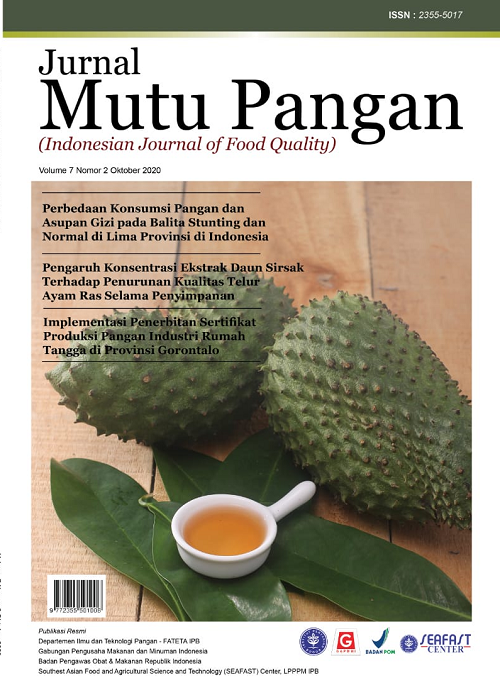Kajian Paparan dan Risiko 3-MCPDE dan GE dari Produk Formula pada Bayi Usia 0-12 Bulan di Indonesia secara Probabilistik
Abstract
The 3-monochloropropane-1.2-diol ester (3-MCPDE) and glycidyl ester (GE) are chemical contaminants detected in vegetable oils and food products containing vegetable oils including formula products. This study aimed to assess the exposure and risk of 3-MCPDE and GE from infants formula products in Indonesia. Prediction of 3-MCPDE and GE levels of formula products was carried out probabilistically using data levels of 3-MCPDE and GE vegetable oil. Estimated daily intake (EDI) of 3-MCPDE and GE of formula products were obtained by multiplying the predicted data by consumption data while risk assessment is done by comparing EDI value with toxicology reference value. The predicted values of 3-MCPDE and GE levels of formula products ranged from 213.60-285.65 and 772.89-922.73 μg/kg. The exposure value of 3-MCPDE and GE of formula products based on Individual Food Consumption Survey (IFCS) was 1.53-2.40 and 5.54-7.11 μg/kgbw/day, while based on serving consumption was 3.31-6.68 and 10.88-21.62 μg/kgbw/day. Results of risk assessment indicated that 3-MCPDE was above 100% (health risk) in exception that of the age group 6-12 months based on IFCS with a value of 76.98-84.34%, the average GE with the T25 margin of exposure (MoE) was 1838-471 which was below 25.000. EFSA defined MoE T25 at 25.000 as GE's low risk to health.
Downloads
References
Arisseto AP, Silva WC, Scaranelo GR, Vicente E. 2017. 3-MCPD and glycidyl esters in infant formulas from the Brazilian market: Occurrence and risk assess-ment. Food Cont 77(2): 76-81. DOI: 10.1016/ j. foodcont.2017.01.028.
Blanchard E, France LRD, Zhu P, Montaigu L De, Schuck P, Ouest A. 2013. Handbook of Food Pow-ders. Woodhead Publishing Limited, Cambridge. ISBN: 9780857098672.
[BPOM] Badan Pengawas Obat dan Makanan RI. 2018. Laporan Tahunan Pusat Riset dan Kajian Obat dan Makanan 2018. BPOM RI, Jakarta.
Delplanque B, Gibson R, Koletzko B, Lapillonne A, Strandvik B. 2015. Lipid quality in infant nutrition: current knowledged. J Pediatr Gastroenterol Nutr 61(1): 8-17. DOI: 10.1097/MPG.0000000000000 818.
[EC] European Commission. 2020. Amending regulation amending Regulation (EC) No 1881/2006 as regards maximum levels of 3-monochloropropanediol (3-MCPD), 3- MCPD fatty acid esters and glycidyl fatty acid esters in certain foods. EU J 310: 2-5.
[EFSA] European Food Safety Authority. 2016. Risks for human health related to the presence of 3‐and‐mono-chloropropanediol (MCPD), and their fatty acid esters, and glycidyl fatty acid esters in food. EFSA J 14(5): 4426. DOI: 10.2903/j.efsa.2016. 4426.
[EFSA] European Food Safety Authority. 2018. Update of the risk assessment on 3‐ monochloropropane diol and its fatty acid esters. EFSA J 16(1): 5083. DOI: 10.2903/j.efsa.2018.5083.
[FAO/WHO] Food Agriculture Organization and World Health Organization. 2009. Principles and Methods for the Risk Assessment of Chemicals in Food. WHO Press, Geneva. ISBN: 9789241572408.
Gianni ML, Roggero P, Charlotte Baudry, Ligneul A, Morniroli D, Garbarino F, Ruyet PL, Mosca F. 2012. The influence of a formula supplemented with dairy lipids and plant oils on the erythrocyte membran omega-3 fatty acid profile in healthy full-term infants: a double-blind randomized controlled trial. BMC Pediatrics 12: 164-171. DOI: 10.1186/1471-2431-12-164.
[IARC] International Agency for Research on Cancer. 2012. Monographs on the Evaluation of Carcino-genic Risks to Human. Vol 101. International Agency for Research on Cancer, Lyon. ISBN: 9789283213246.
[JECFA] Joint FAO/WHO Expert Committee on Food Additives. 2017. Evaluation of Certain Contaminants in Food. WHO Press, Geneva. ISBN: 978-92-4-069642-6.
[Kemenkes] Kementerian Kesehatan. 2019. Peraturan Pemerintah Republik Indonesia Nomor 28 Tahun 2019 tentang Angka Kecukupan Gizi yang dianjurkan untuk Masyarakat Indonesia. Kemenkes, Jakarta.
[Kemenkes] Kementerian Kesehatan. 2018. Buku Hasil Riset Kesehatan Dasar 2018. Lembaga Penerbitan Litbangkes, Jakarta. ISBN: 978-602-373-118-3.
[Kemenkes] Kementerian Kesehatan. 2014. Buku Studi Diet Total: Survei Konsumsi
Makanan Individu Indonesia 2014. Lembaga Penerbitan Litbangkes, Jakarta. ISBN: 978-602-1099-31-5.
Leigh J, MacMahon S. 2017. Occurrence of 3-mono-chloropropanediol esters and glycidyl esters in com-mercial infant formulas in the United States. Food Addit Contam Part A Chem Anal Control Expo Risk Assess 34(3): 356-370. DOI: 10.1080/194400 49. 2016.1276304.
Luron IE, Blat S, Boudry G. 2010. Breast-v. formula-feeding: impacts on the digestive tract and immediate and long-term health effects. Nutr Res Rev 23(1): 23-36. DOI: 10.1017/S0954422410000 065.
MacMahon S, Begley TH, Diachenko GW. 2013. Occurrence of 3-MCPD and glycidyl esters in edible oils in the United States. Food Addit Contam: Part A. 30(12): 2081-2092. DOI: 10.1080/19440049. 2013. 840805.
Martin CR, Ling PR, Blackburn GL. 2016. Review of infant feeding : Key features of breast milk and infant formula. Nutrient 8(5): 1-11. DOI: 10.3390/ nu80 50279.
Novian R. 2019. Profil Komposisi Asam Lemak pada Produk Formula di Indonesia [Skripsi]. Bogor: Institut Pertanian Bogor.
Pudel F, Benecke P, Vosmann K, Matthäus B. 2016. 3-MCPD- and glycidyl esters can be mitigated in vege-table oils by use of short path distillation. Eur J Lipid Sci Technol 118(3): 396-405. DOI: 10.1002/ ejlt. 201500095.
Ryan T. 2013. Sample Size Determination and Power. John Wiley, New Jersey. ISBN: 9781118439241. DOI: 10.1002/9781118439241.
Spungen J, Macmahon S, Leigh J, Flannery B, Kim G, Chirtel S, Smegal D. 2018. Estimated U.S. infant exposures to 3-MCPD esters and glycidyl esters from consumption of infant formula. Food Addit Contam Part A Chem Anal Control Expo
Risk Assess 35(6): 1085-1092. DOI: 10.1080/19440049. 2018.1459051.
Wohrlin F, Fry H, Lahrssen-Wiederholt M, Preiss-Weigert A. 2015. Occurrence of fatty acid esters of 3-MCPD, 2-MCPD and glycidol in infant formula. Food Addit Contam Part A 32: 1810-1822. DOI: 10.1080/19440049.2015.1071497.
Zelinkova Z, Dolezal M, Velisek J. 2009. Occurrence of 3-chloropropane-1, 2-diol fatty acid esters in infant and baby foods. Eur Food Res Technol 228: 571-578. DOI: 10.1007/s00217-008-0965-0.

















